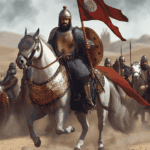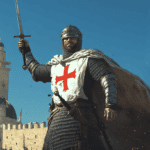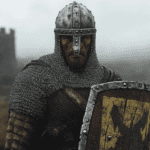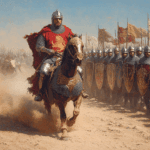
The Battle of Didgori, fought on August 12, 1121, stands as one of the most significant military engagements in Georgian history. This pivotal battle saw King David IV “the Builder” of Georgia lead his forces to a decisive victory against a powerful Seljuk-led Muslim coalition. The battle not only secured Georgia’s independence but also marked a turning point in the country’s history, ushering in a period of expansion and cultural flourishing known as the Georgian Golden Age.
Rise of King David IV
David IV ascended to the Georgian throne in 1089 at a time when the country was in dire straits. The Seljuk Turks had devastated much of Georgia through repeated incursions, leaving the kingdom fragmented and vulnerable. However, David was not content to accept this state of affairs. From the outset of his reign, he embarked on an ambitious program of military, political, and cultural reforms aimed at strengthening Georgia and expelling the Seljuk invaders.
David’s Early Reforms and Victories
In the years leading up to Didgori, David implemented several key reforms that would prove crucial to his later success:
- Military Reorganization: David overhauled the Georgian army, introducing new tactics and improving its organization and discipline.
- Kipchak Settlement: In 1118-19, David settled 40,000 Kipchak families in Georgia, significantly bolstering his military manpower.
- Territorial Expansion: Through a series of campaigns, David gradually reclaimed Georgian territories, capturing important fortresses such as Samshvilde (1110), Rustavi (1115), and Lori (1118).
These reforms and early victories set the stage for the climactic confrontation at Didgori.

The Battle of Didgori
The Muslim Coalition
Alarmed by David’s growing power and the threat he posed to Muslim dominance in the region, a coalition of Muslim rulers assembled a massive army to crush the Georgian king. This coalition included:
- The Seljuk Sultan Mahmud II
- Il-Ghazi, the Artuqid ruler of Mardin
- Tughan-Arslan, the ruler of Arzen and Bidlis
- Various other Muslim rulers and mercenaries
Estimates of the coalition’s strength vary widely, with some sources claiming its strength ran into the 100,000s. Whatever the number, it’s clear that the Muslim force significantly outnumbered the Georgian army.
Georgian Forces
King David’s army, while much smaller, was well-trained and highly motivated. It consisted of:
- Georgian heavy cavalry and infantry
- Kipchak horse archers
- A contingent of Crusaders (about 200 knights)
- 500 Alanian mercenaries
The total Georgian force is estimated to have numbered around 56,000 troops.
Battle Strategy
King David chose the battlefield carefully, selecting a narrow valley near Didgori that would negate the enemy’s numerical advantage. The Georgian army was positioned at the entrance of the valley, with heavily forested mountains protecting their flanks. David blocked retreat routes with felled trees, creating a “fight to the death” scenario for his troops.
The Seljuk vanguard under Ilghazi – comprising light cavalry and archers – camped at Didgori’s narrow pass, underestimating Georgian strength. Contemporary accounts describe how Ilghazi’s scouts reported only a small Georgian force, luring him into complacency.

Decapitation Strike
At dawn on August 12, a contingent of 200 Kipchak horse archers approached Seljuk commanders under the guise of defecting. When granted an audience they assassinated 12 senior Seljuk leaders with close-range archery, throwing their command structure into chaos. Simultaneously, they signalled David to commence the main assault.
The Battle Unfolds
Initially, the 200 Crusader knights charged the Seljuk vanguard in a classic heavy cavalry wedge. Their full-plate armor deflected arrows while lances shattered Seljuk lines. This pinned the Muslim center as David executed his pincer movement.
On the left flank, 15,000 reserve troops under Prince Demetriuswho had hidden on the western heights, attacked the Seljuk right with Kontos spears. From the right flank some 10,000 Georgian heavy cavalry charged downhill into the Seljuk left. To complete the trap, Kipchak archers enveloped the rear, firing arrows into the collapsing Seljuk formation.
The Seljuk army – estimated at well over 100,000 but cramped in the 2km-wide valley – could neither retreat nor reinforce. Georgian infantry then advanced with pikes and axes, exploiting gaps created by cavalry. Within three hours, the Seljuks broke into panicked flight. King David, leading from the front, personally led charges against the enemy, inspiring his troops with his bravery.

The Muslim coalition, despite its huge numerical advantage, began to crumble under the relentless Georgian assault.
Divine Intervention?
Georgian chronicles and later traditions speak of divine intervention during the battle. Some accounts claim that St. George, the patron saint of Georgia, appeared on the battlefield, leading the Georgian cavalry to victory. While such stories should be viewed as legendary embellishments, they reflect the profound impact the battle had on Georgian national consciousness.
The Outcome
The Georgian victory became a slaughter with Seljuk forces trampling each other trying to escape the valley. Kipchaks harried retreaters for 60km to Manglisi. Local rivers were reportedly clogged with corpses for days.
The Battle of Didgori ended in a resounding victory for King David and the Georgian forces. The Muslim coalition was utterly routed, with many of its leaders killed or captured. The Seljuk Sultan Mahmud II barely escaped with his life, fleeing the battlefield in disguise.
The Georgian army captured the entire Seljuk camp, including Ilghazi’s ceremonial tent and war chest, 400 siege engines intended for Tbilisi, 12,000 pack animals with supplies and 40,000 prisoners later used for reconstruction projects.
The victory was so complete that Georgian chroniclers referred to it as the “miraculous victory”.

Aftermath and Significance
Perhaps the most immediate and tangible result of the victory was the liberation of Tbilisi, Georgia’s ancient capital, the following year. After four centuries of Muslim rule, Tbilisi was finally returned to Christian Georgian control in 1122.
The victory at Didgori opened the way for further Georgian expansion. In the years that followed, David extended Georgian influence across much of the South Caucasus, liberating Shirvan in 1123 and Ani in 1124. By the end of his reign, Georgia had become the dominant power in the region, with a territory stretching from the Black Sea to the Caspian.
Cultural and Religious Renaissance
The peace and stability brought about by the victory at Didgori allowed David to focus on internal development. He promoted education, founding the renowned Gelati Academy in 1106. This institution became a major center of learning, often referred to as “a new Athens” or “a second Jerusalem.”
David also pursued a policy of religious tolerance unusual for the time. While firmly Orthodox Christian himself, he allowed other faiths to practice freely within his realm, contributing to Georgia’s cultural and economic flourishing.

Legacy in Georgian History
The Battle of Didgori and the reign of David IV marked the beginning of Georgia’s Golden Age, a period of political, economic, and cultural zenith that would last until the Mongol invasions of the 13th century. David’s epithet “the Builder” reflects his role not just in military conquest, but in the comprehensive rebuilding and development of Georgia.
The battle remains a potent symbol of Georgian national pride and resilience. It is commemorated annually in Georgia, and David IV is venerated as a saint by the Georgian Orthodox Church.




